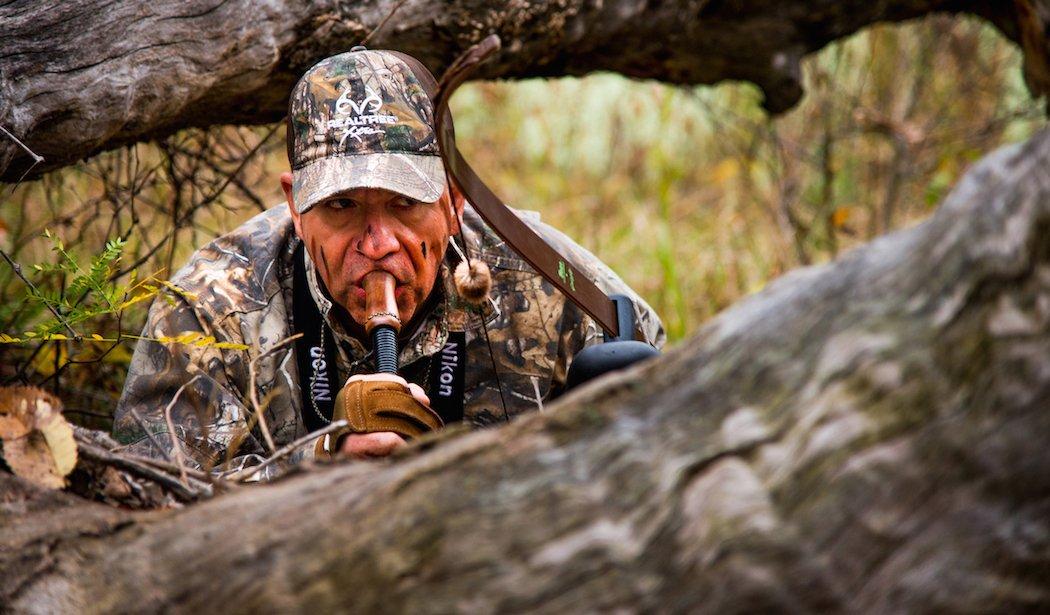Do You Deer Hunt from the Ground?
I was just getting comfortable and glassing the opposite slope when I heard the deer. The unmistakable cadence of leaves being crunched underfoot in a dry November woods grew louder as it got closer. Turning my head slowly to the left, back along the oak ridge, I spotted the approaching whitetail. It was a buck with one of those gnarly racks that make good conversation pieces, if not the Pope & Young Club records book.
When he passed me, and there was no reason to think that he wouldn't, the buck would be about 30 yards away. A steady north wind was blowing down toward the Mississippi River a mile or so away. He was heading south, and I was positioned to the west of the ridge path he was following like a bird dog trailing a running covey. If detected, I would have only my clumsiness and the buck's keen eyesight to blame. I wasn't 20 feet up in a tree on a stand; I was stretched out atop a huge fallen tree, with my back against the root wad.
The trick now was to get off a shot at the buck's eye level without being busted as I drew, but I knew that if I applied the lessons that Jim Brush had taught me, things would work out. There's something about a 14,000-square-foot museum full of bowhunting trophies that instills confidence in any advice that the owner might give you. And on that count, Jim Brush's bowhunting tips are golden.
The Galesville, Wisconsin, archer is one of the most prolific bowhunters in the world and has a museum filled with trophy mounts from all over the planet to prove it. Not only is his Brush Trophy Room Museum a Midwestern mecca for envious archers, it's a popular waypoint for schoolchildren on field trips.
The full-body mounts of African, Asian, European and North American game animals taken by Brush, his wife Cindy and nephew Travis are displayed in natural settings that depict the various habitats the game animals call home. A bowhunter has to see the museum collection to appreciate fully the hunting skills that Brush developed over close to a half-century of bowhunting. What is truly remarkable about him is that the vast majority of his trophies, including dozens of Boone and Crockett and Pope and Young trophies, were taken while Brush was hunting from the ground, without benefit of any blind other than what could be fashioned from the natural cover around him.
When you stop and think about it, Brush's favorite hunting approach shouldn't come as a big surprise. He grew up in the era when archers such as Fred Bear were popularizing bowhunting, and Bear and his contemporaries hunted from the ground for the most part. Of course, they got their inspiration from the first North American bowhunters, the Indians, who had to depend on their stealth and ground-hunting savvy to feed their families. I've always hunted deer from the ground, and I don't consider hunting from a treestand to be any advantage where I hunt, says Brush. There's lots of ground-level concealment available and I like to keep it simple; I also like to move when the need arises. Deer change travel routes when the rut is on, and they might bed down and travel in different places because food sources change. I've just always found it simpler all around to hunt from the ground.
Brush's hunting territory is his 1,000-acre farm in the Rose Valley area of Buffalo County, Wisconsin. Typically, there are creek bottoms and valleys planted with corn that meet steep oak ridges. These rise to border other, vaster fields of corn. Deer trade back and forth between food sources, and their wooded bedding areas are sandwiched between the fields.
Brush's approach is fairly straightforward. He decks out with Realtree camo from head to toe, sits down on a comfortable cushion in a cluster of small trees that are parallel to the trails that he's hunting, leans his bow with nocked arrow against a tree or a small tripod, and waits. The area in front of him is open, because that's where he hopes to get a shot. Deer are either going to their bedding areas in the morning or travelling to food sources in the evening. For a morning hunt, Brush enters the woods before daylight and goes to a location that he marked in daylight or that he used in previous seasons. If a lot of deer are moving by him, he might choose to stay put. Otherwise, he'll slip through the forest slowly and quietly to another locale he feels is promising.
The important thing to me is having cover, even the hillside, on my back so that I'm not silhouetted, adds Brush. Sometimes I'll spread a patch of camo material behind me if necessary, but I prefer natural cover for a backdrop—broken branches, bushes, whatever.
When you have to move, you move as slowly and quietly as possible; when you draw your bow, you do it when the deer is behind a big tree, or looking somewhere else or is otherwise preoccupied, says Brush. There are a lot of places to set up, so I don't keep going back to the same spot all the time. It doesn't take long for deer to figure things out if your scent saturates an area. They won't go there.
Brush invited me to hunt with him during the first week of November when the rut in that area of Wisconsin was nearing a peak and the bucks were on the move. My first two days were spent harvesting a doe, which I did the second evening when one walked near my spot with a grunting 145-inch buck in tow. I shot the doe and the buck hightailed it. I was hunting where Earn-A-Buck was in effect and a bowhunter was required to shoot a doe and check it in at a weigh station before he could receive a buck tag.
The next afternoon found me on another ridge, situated above a trail where I figured bucks would walk in order to catch up-drafting thermals and, hopefully, the scent of willing does. My ground spot was behind the fallen tree, and there were saplings behind me that I could lean against. I also had hung a Wildlife Research Center Golden Estrous scent wick on a limb overhanging the trail. To block the buck's view when I drew the string of my Mathews bow, a huge oak was between the dripper and me. As the buck grew closer, I wondered if I could pull off a feat that Jim Brush had pulled off hundreds of times.
I waited and the subtle crunching of leaves seemed to grow into a steady roar. Then, just as planned, the buck stopped at the wick and I drew. When he walked on a few second later, I put the 30-yard-pin low behind his shoulder, followed him for a moment and released the 125-grain Thunderhead-tipped shaft. The buck ran about 35 yards, then stopped and looked back, as if to wonder what all the commotion had been about. A few seconds passed, and then he went wobbly. Finally, he dropped to the ground and slid almost all the way to the creek crossing where I had entered my hunting area. He scored 154 2/8 non-typical.
Hunting from the ground might not be the best approach for areas where dense growth inhibits a hunter's view, or where there isn't much cover at all, but in typical northern woods it will work for the bowhunter who is stealthy and takes pains to keep himself hidden.
The Indians proved that, and so did Jim Brush.
Click here for more deer hunting articles and videos.
Check us out on Facebook.








